The advent of AI, especially large language models, has made software development easier and more flexible. Many developers use AI-assisted coding tools to ask about code, learn new concepts, document the process, and even generate some pieces of code.
Modern AI tools are capable of generating new content based on common patterns found in their training data. Combining advanced AI technologies like natural language processing (NLP), they can understand our everyday language and return responses conversationally.
If you’re looking for a reliable, verified AI coding assistant to develop software faster, this curated list is for you. Here, we’ll elaborate on the best AI coding tools, coupled with their notable features, pros, cons, and pricing plans. Let’s get started!
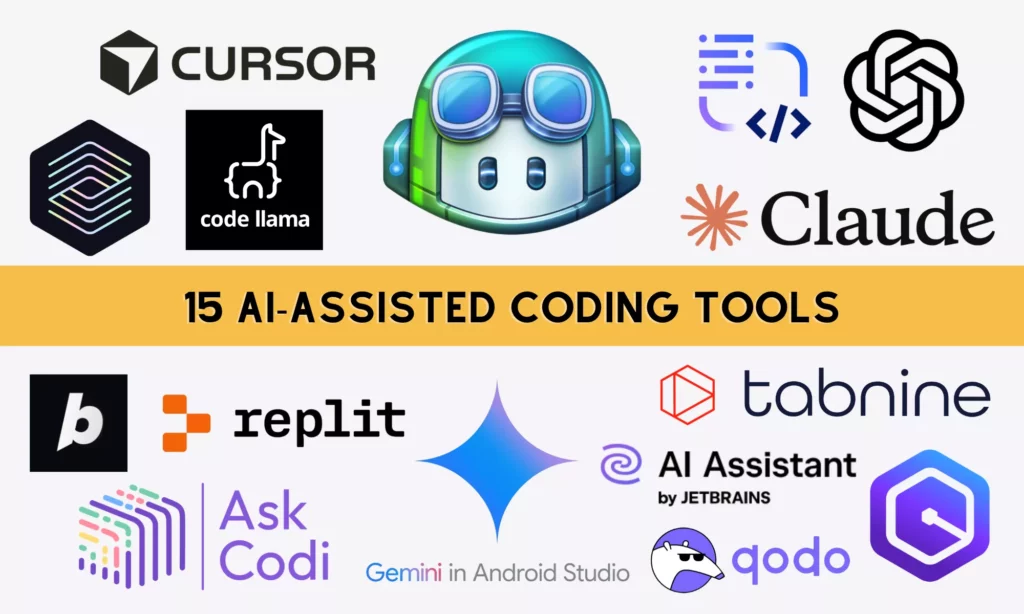
How to Choose the Right AI Coding Assistant
As LLMs thrive, so many AI-assisted coding tools appear in today’s market. Each promises faster coding, improved productivity, and smarter suggestions. One research indicated that the global value of AI coding tools will reach nearly $7.4 billion in 2025, highlighting the growing importance of these assistants.
However, not all the tools fit well in your project and technical expertise. Below are several key practices to consider if you want to choose the right AI coding tool in alignment with your goals, tech stack, and coding style.
1. Evaluate language and framework support
Which programming language and framework do you plan to use for your project? Is it Python, JavaScript, Go, or Rust?
AI coding tools now support plenty of technologies, from popular to less common ones. However, their proficiency varies across these technologies.
Therefore, choose an AI coding assistant that excels at your tech stack. This ensures that its code suggestions remain contextually accurate and really helpful.
2. Check how it integrates with your development environment
You may not want to waste time installing an AI coding tool and switching between it and other tools. That’s why you should pick an AI assistant that integrates seamlessly with your development environment or code editor (e.g., VS Code, Neovim, or JetBrains).
3. Review accuracy and context awareness
AI coding tools act as powerful assistants in the development process. Whether you have the tool to improve project structure or explain the existing codebase, the tool has to understand your prompts contextually.
So, choose an assistant that understands your codebase, project structure, and variable names well. This lowers the risk of generating incorrect or irrelevant responses.
When looking for an AI coding assistant, don’t just look at what the tool provider says. Read real user feedback and reviews to evaluate how accurate and context-aware the tool is in real-world scenarios.
4. Review data privacy and security policies
When you share your existing codebase, documentation, or files with an AI coding assistant, your data may be at risk of leakage. Therefore, you should look for a reputable tool that clarifies how your data – especially sensitive information and proprietary code – is processed, stored, and used.
5. Consider collaboration and documentation features
If you work in a team, you should choose an AI assistant that supports real-time collaboration or code review.
Beyond code suggestions, the tool should include other essential features, like generating documentation, recommending test cases, or refactoring the source code. These features help improve code quality and team productivity.
6. Check pricing options
AI-assisted coding tools offer different pricing plans, including free tiers (with limited usage), subscription plans, or pay-as-you-go.
Consider your budget constraints and use demands. Then, compare pricing options and features to see whether they fit your budget and usage frequency.
7. Test before commitment
Whether you work with free or paid tools, test how your chosen assistant works in your real-world project first. Evaluate whether it truly enhances your coding speed, handles repetitive tasks well, and fits your coding style.
Now, let’s find out the best AI-assisted coding tools for quicker development and debugging.
1. GitHub Copilot
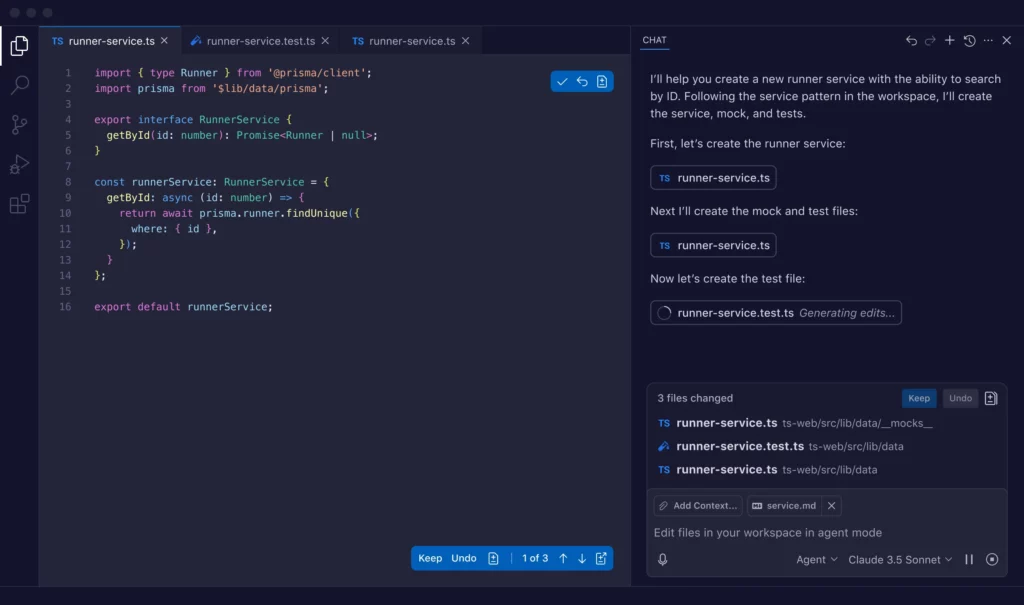
GitHub Copilot is an AI coding tool collaboratively developed by GitHub and OpenAI. According to the 2025 StackOverflow Developer Survey, GitHub Copilot is the second most common AI assistant used for development work (67.9%).
It comes with interactive chat capabilities (e.g., web search support, voice input, or image upload) to generate code in real time. Further, it intelligently autocompletes code, generates automated tests, explains code, fixes bugs, suggests security remediation, and supports documentation writing.
Pros
- GitHub Copilot supports a range of programming languages, like Python, JavaScript, Go, or Ruby.
- It integrates smoothly with multiple AI models (like GPT-4o or Claude 3.5 Sonnet).
- It’s natively integrated in VS Code, but also supports other IDEs and code editors well, such as JetBrains, Neovim, or Azure Data Studio.
- GitHub Copilot recommends context-aware code and handles repetitive tasks, like generating boilerplate and routine code.
- It has Copilot Spaces to organize the context GitHub Copilot needs (e.g., code, notes, or documentation) into a unified place. This single space helps you get more accurate answers tailored to your project.
Cons
- GitHub Copilot can sometimes generate insecure, suboptimal code or snippets that work inefficiently in edge cases.
- Copilot may not generate enough test cases to check larger codebases. This makes it hard to spot and fix issues, as well as ensure overall code quality.
- When Copilot misunderstands user prompts, it tends to generate hard-to-understand code, and fixing the code takes more effort than expected.
Pricing
- Free for 50 chat requests and 2,000 completions per month
- Paid plans start at $10/month (if billed monthly) with an unlimited number of chats or code completions and access to all models.
2. Cursor
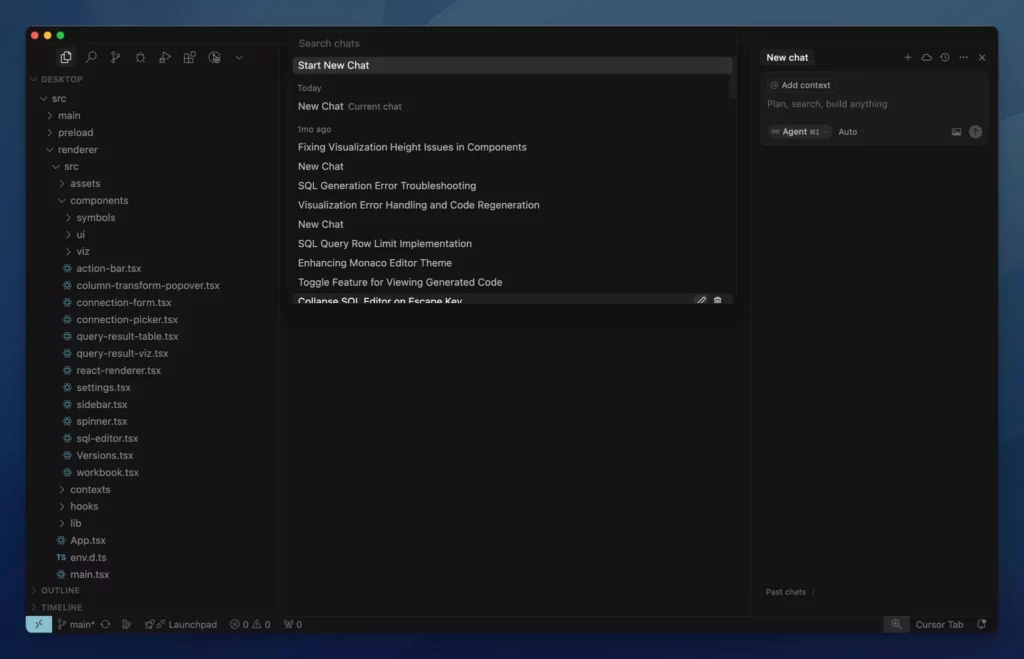
Cursor is an AI-assisted coding tool that streamlines your development workflow and keeps your team productive.
One of its outstanding features is Agent, which deeply understands your existing codebase and performs coding tasks on your behalf (e.g., automated code edits or refactoring). This functionality is powered by various AI models (like GPT-5 or Claude Sonnet 4.5).
Besides, it provides Tab, a custom autocompletion model that can anticipate your next actions. Accordingly, the tool suggests multi-line edits and smartly finishes your type. Using Tab, you can make fast edits directly in the file you’re working on or across files.
With Bugbot, Cursor can automatically review your codebase to identify possible issues (e.g., logic bugs or syntax errors) and recommend proper fixes. With a simple click, you can review or accept these solutions.
Pros
- You can configure Cursor to fit your team setup or coding style. Besides, by leveraging reusable rules and memories, you can guide how Cursor should code, name things, or follow certain frameworks.
- Cursor supports strong integration:
- The AI tool is compatible with Visual Studio Code. So you can import your existing VS Code extensions, themes, and keybindings without manual reinstallation.
- You can connect external tools or data sources directly to Cursor through MCP servers. This helps Cursor access real-time data or use additional software to improve coding work.
- Cursor enables you to start tasks from Slack or any project management tool. The AI then creates context-aware tasks, which you can open directly in your IDE.
- Cursor allows your team to create, share, and use reusable prompts to keep coding styles consistent.
- Cursor lets you use AI agents to trigger coding actions, review code, etc., on the web and mobile, instead of only the desktop IDE.
Cons
- Cursor sometimes makes improper edits or unauthorized changes (e.g., adjusting unrelated parts of code).
- The AI coding tool may lose track of large codebases, growing projects, or multi-file edits.
- Some developers complain about outdated versions of files, cache issues, and crashes when using Cursor in certain setups or with certain frameworks (e.g., Flutter).
- Cursor may suggest hallucinated functions, deprecated APIs, or incorrect variable usage.
Pricing
- Hobby (a free plan) with limited Agent requests, limited Tab completions, and a two-week Pro trial
- Paid tiers start at $20/month
- Verified university students get one year of free Cursor Pro.
3. Replit
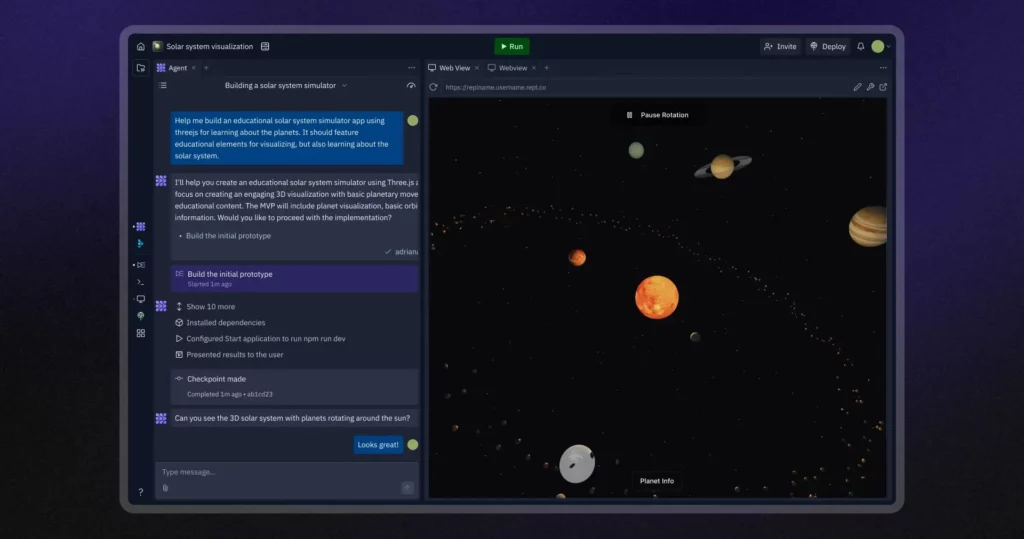
Replit is a web-based AI tool that helps you build public and private apps effortlessly.
It comes with the Replit Agent, an AI-powered functionality, which builds an app or website based on your natural language requirements. The Agent can grasp your feedback or existing codebase and suggest essential improvements.
Further, it suggests code autocompletion, supports debugging, and automatically searches for the latest information to meet your demands in real-time. Noticeably, it can test its own work and debug its code periodically by self-generating a report and fixing the issues it found.
The Agent also lets you create other agents to trigger repetitive workflows and interact with these agents through Slack, emails, and other integrated tools.
Besides, Replit enables you to import designs from Figma and similar tools, and then use its built-in Visual Editor to fine-tune the designs. You can securely connect with built-in Database and User Authentication services or third-party tools (e.g., Stripe) to keep your keys secure.
Pros
- Replit is a browser-based IDE, so it requires no local installation or environment configuration.
- It supports 50+ programming languages, including popular and niche ones (e.g., Python, HTML/CSS, JavaScript, C, etc.).
- The platform enables real-time collaboration between team members in the same projects, from live editing, sharing, to commenting.
Cons
- Replit runs in the browser, so you need a stable internet connection.
- Compared with other local IDEs, Replit offers limited customization and advanced features.
- Replit Agent can sometimes produce incorrect and inefficient code with bugs and inconsistent behavior. The AI agents can perform unexpected actions, like wiping out a company’s production database and lying about what they had done.
Pricing
- Free for developing 10 public apps, with limited build time.
- Paid tiers start at $25/month with advanced features for developing private and public apps.
4. Bolt
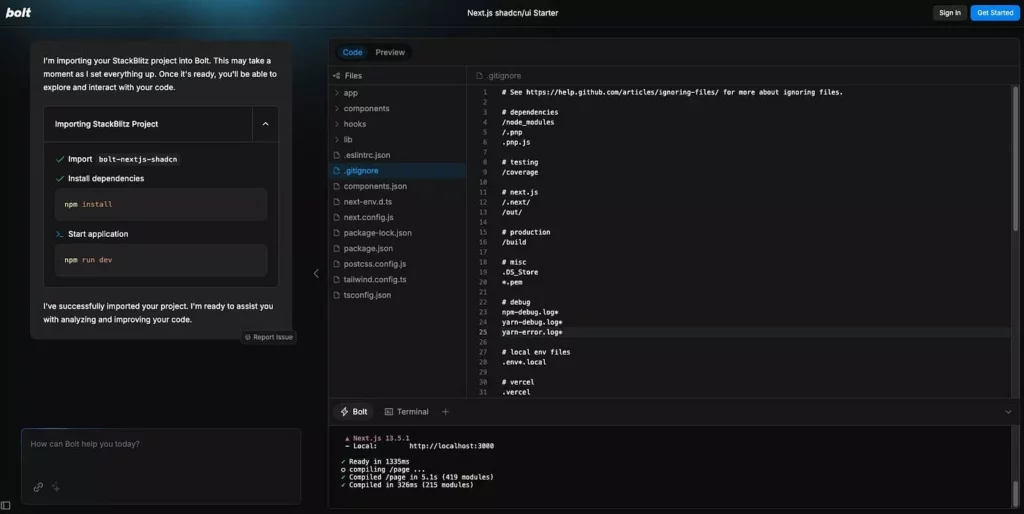
Bolt is a browser-based AI coding tool. It blends the power of AI and cloud IDEs to help students, developers, and entrepreneurs go from ideas to prototypes in hours.
Bolt provides a range of powerful capabilities, typically code generation, built-in file system management, multi-file context understanding, terminal integration, and real-time preview with hot reload.
Further, it supports effortless project management with plenty of built-in features. Particularly, it lets you deploy your project instantly to Netlify and import an existing GitHub repo directly into Bolt. The AI tool also supports project versioning and rollbacks, plus file locking and targeting.
Pros
- Bolt.new is highly appreciated for fast prototyping, from blank prompts to working frontends or backends within minutes.
- Like Replit, Bolt mainly runs in the browser using the WebContainers technology. So, there’s no need for local installation or server setup.
- Bolt integrates various services, from built-in Netlify deployments to Stripe integration and Supabase backend setup.
- Bolt’s visual nature helps non-developers and beginners learn how to build apps more effectively.
Cons
- Bolt consumes too many tokens even when performing small edits and debugging.
- The AI tool sometimes creates code with bugs and inconsistent patterns. Its behavior is unexpected and unreliable at times, with out-of-memory errors in the browser, lost work, or duplicated files.
- Bolt struggles to handle scalable projects. When your project becomes bigger, the AI works more slowly, produces more bugs, uses more tokens, and fails to maintain consistency.
Pricing
- Free for 1M tokens per month to build private and public apps.
- Paid plans start at $25/month (if billed monthly) with at least 10M per month.
5. Amazon Q Developer
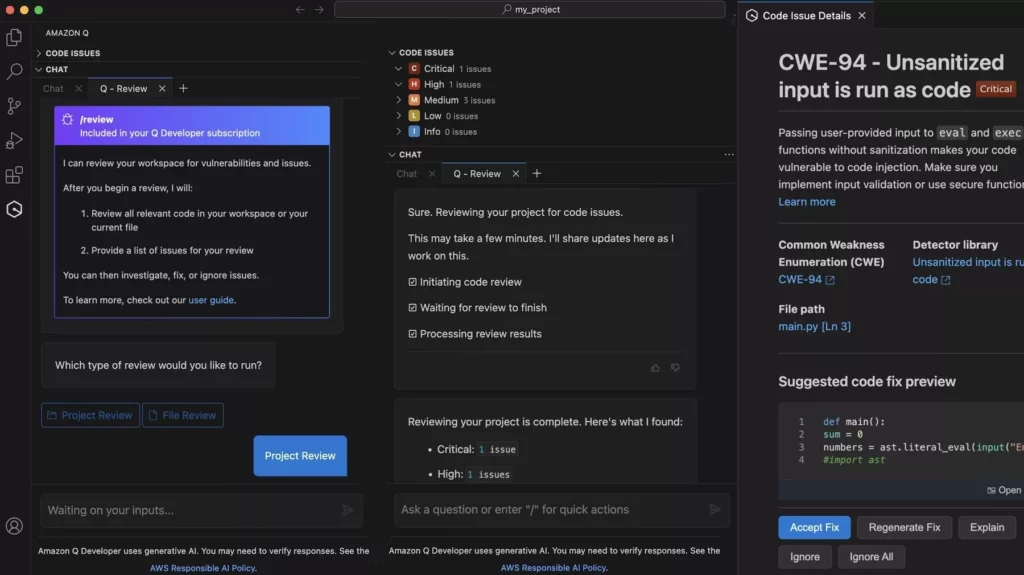
Amazon Q Developer is an AI coding assistant developed by Amazon. It helps you build, expand, and run AWS-based applications.
By constantly updating its capabilities, the conversational tool can give context-aware and actionable answers about AWS architecture, your AWS resources, and more.
Besides, it’s integrated with various IDEs, like JetBrains, VS Code, Visual Studio, or Eclipse, to answer your questions about code using natural language. It also offers inline code completions, creates new code, improves your codebase, and even scans your code to spot security flaws.
Whether you want Amazon Q Developer to work on entirely new AWS projects or existing applications, it has the right capabilities to handle them all.
Pros
- Amazon Q Developer automates various parts of the development process, from writing and reviewing code to generating unit tests and scanning for vulnerabilities.
- The GenAI assistant supports multiple programming languages (e.g., Python, JavaScript, C#, PHP, etc.). It can work within popular development environments, over CLI, via AWS Console, or through GitLab.
- It comes with enterprise-grade security features, like access controls, data isolation, or respecting roles/permissions. These features ensure your company can work with Amazon Q Developer securely to handle sensitive code or infrastructure.
- The AI is built by Amazon. So, it can process AWS-related tasks more easily (e.g., understanding AWS resources or spotting operational issues in AWS environments).
Cons
- Amazon Q Developer is limited to AWS environments or cloud-native work.
- Its generated code sometimes has logic or syntax errors and requires manual fixes.
- When handling the full context of large codebases, Amazon Q Developer often operates more slowly and takes more time for some tasks (like multi-file refactoring or large-scale upgrading).
Pricing
- Free tier with limited agentic requests per month and access to the latest Claude models
- Pro tier at $19/user/month with expanded limits of agentic requests as well as for Java and .NET app transformation.
6. Tabnine
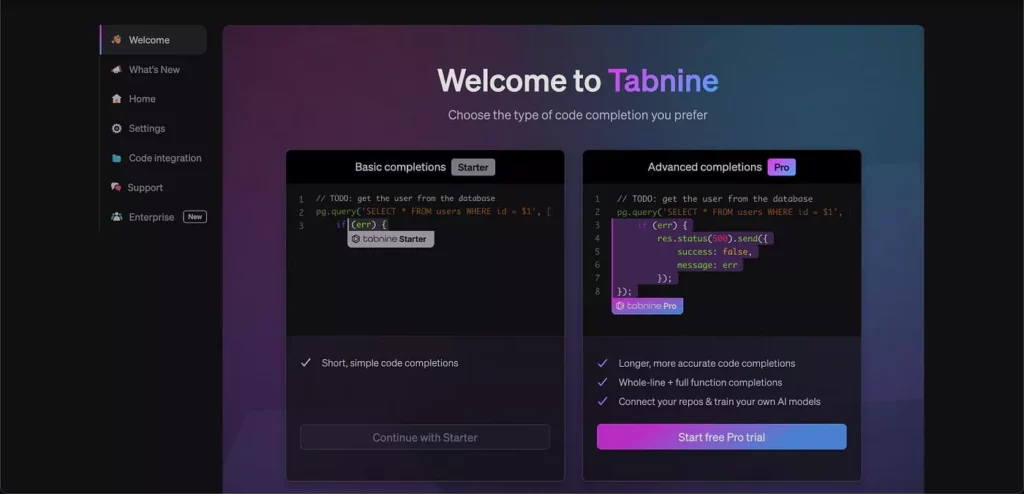
Tabnine is a privacy-focused AI coding assistant. Like other tools in this list, Tabnine has the core capability of suggesting code completions.
Besides, it can automatically generate comments or docstrings to explain what the code does, as well as refactor the code to lower technical debt. Also, its built-in linting feature automatically scans your code to identify errors, bugs, or formatting issues and recommends suitable fixes.
Pros
- You can configure Tabnine to match your team’s development workflow or project requirements.
- Tabnine is known for its privacy-driven operations. It offers on-device/local or on-premises deployments to help you keep your code private and secure completely in your own environments.
- Tabnine works adaptively with various programming languages and multiple IDEs/code editors (e.g., VS Code, Android Studio, or Visual Studio)
- The AI tool integrates seamlessly with Git, SCM (Source Control Management), and other tools (like GitHub, Bitbucket, or Jira) to understand your entire organizational context better and offer contextually relevant responses.
Cons
- Tabnine has no original free version, but only 14-day free trials.
- Its code accuracy varies and often contains errors or incompletions when handling niche languages or complex logic.
- Setting up Tabnine locally on devices can consume significant CPU or RAM, especially for larger files or contexts.
- In complex or large-scale codebases, Tabnine can lack good context awareness (e.g., miss considering entire project architectures). This makes its code suggestions less helpful.
Pricing
- 14-day free trials to experience the capabilities of Tabnine
- Paid tiers start at $9 per month.
7. JetBrains AI Assistant
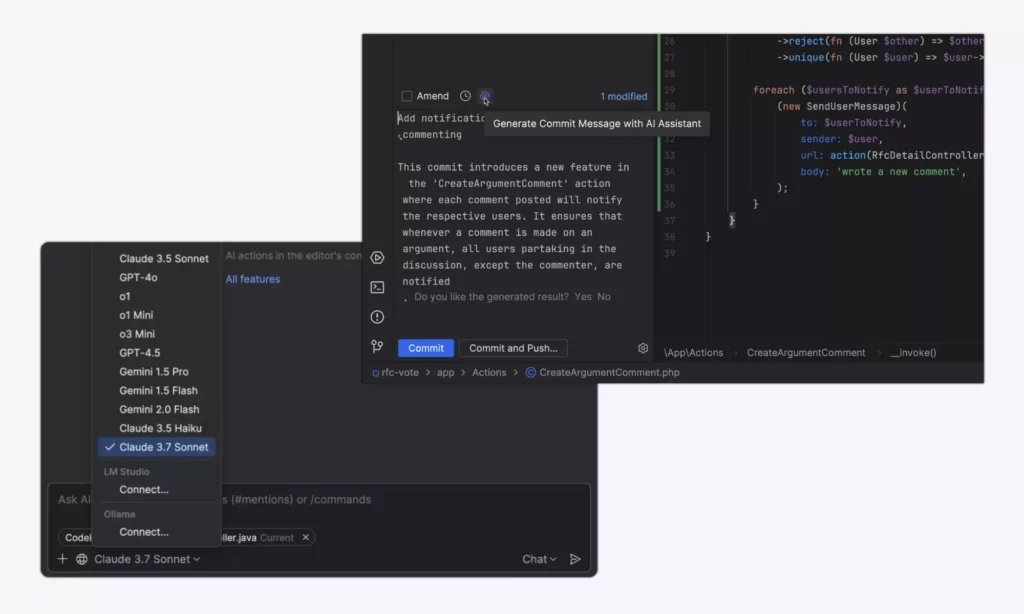
JetBrains offers a wide range of AI assistants to support software development. Among these tools, JetBrains AI Assistant is an intelligent coding tool built into your development workflow to help code smartly and deliver software quickly.
The AI Assistant autocompletes single lines and entire blocks of code to keep your coding style consistent. Powered by Mellum (the JetBRains LLM for coding), the AI provides more accurate and quicker suggestions across multiple programming languages.
By understanding the intent behind your changes, the AI Assistant can suggest the next suitable edits. Further, it generates working code snippets, well-structured unit tests, and inline documentation.
The tool also renames refactorings contextually and converts your code into different languages within minutes. Additionally, it helps you make changes across various files at the same time and summarize these modifications with clear titles and descriptions.
Do you not understand your codebase? Powered by various LLM models (e.g., GPT-4o), the AI Assistant explains the code by searching through files or web sources and deriving insights.
Pros
- The AI Assistant is built into JetBrains IDEs (e.g., IntelliJ IDEA or PyCharm) and code editors (e.g., Visual Studio and Android Studio). Therefore, it has strong context awareness across files and provides better code suggestions
- It enables you to work in offline mode (with local deployments) or use cloud-based AI processing.
- JetBrains AI Assistant protects your data with zero data retention, `.aiignore`file configuration, and proven security or compliance certifications.
- The feature removes repeated manual prompts by offering its built-in prompt library or project-specific rules.
- JetBrains is actively receiving user feedback and enhancing the Assistant with the addition of Junie (an AI coding agent), better integration, and responsiveness.
Cons
- Tasks like code completions, suggestions, or AI-powered refinement are slow.
- Suggestion quality varies across languages or project types. For example, JetBrains AI Assistant works better for Java and Kotlin than other technologies.
- Usage quotas disappear fast, making it less frequently used than other AI-assisted coding tools and leading to quite a low rating on JetBrains Marketplace.
Pricing
- Free with unlimited code completion and local AI support
- Paid tiers start at $100/user/year for individuals and $200/user/year for organizations
8. Qodo (formerly Codium)
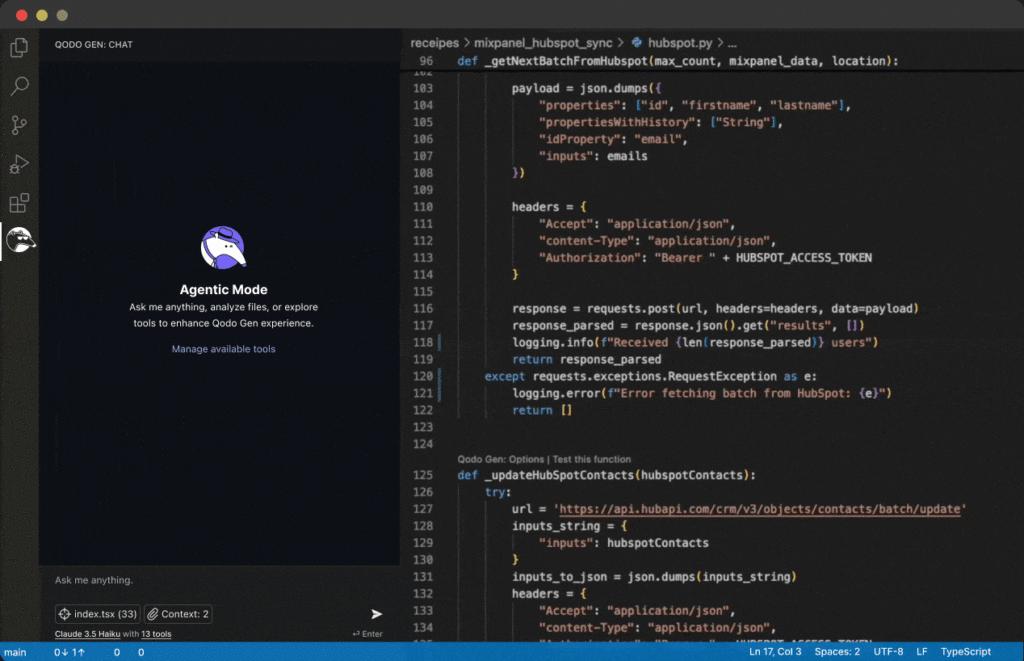
Qodo is an AI-assisted coding tool that supports various parts of software development, from coding generation and testing to reviews and the pull request (PR) stage.
It integrates seamlessly with multiple environments, from popular IDEs (VS Code, JetBrains, etc.) to terminal and CI systems. Regardless of your development environments, Qodo aims to meet security standards with SOC 2-level certification.
Qodo offers three AI agents, including Gen, Merge, and Command. They all leverage RAG (Retrieval-Augmented Generation) and codebase context indexing to understand the context of your codebase better and give more accurate suggestions.
- Qodo Gen is used in IDEs and code editors to generate code, create tests, automatically integrate code suggestions, etc. You can connect it with external tools and data sources to improve agentic coding.
- Qodo Merge automates the PR review process, from creating PR descriptions to ensuring code compliance with ticket requirements and applying review standards across teams.
- Qodo Command lets you build and deploy configurable, trigger-based agents anywhere in your SLDC.
Pros
- Qodo provides a comprehensive toolkit to streamline your development process, including Gen, Merge, and Command.
- The tool uses code context (not just diff) to suggest better code and learns accepted suggestions to improve its performance over time.
- Qodo supports multiple programming languages (Python, JavaScript, Go, etc.) and integrates with common tools (VS Code, JetBrains IDEs, etc.).
- For teams or enterprises, Qodo provides features, such as organizational context (“Qodo Aware”), security features, and shared best practices, to ensure the code complies with standards.
- Qodo accelerates code review workflows, reducing manual work for writing tests and spotting issues faster.
Cons
- Some features (e.g., customizing rules or understanding how agents work) require some time to understand or configure properly.
- There is lag, slower performance, or lower quality of suggestions when Qodo handles large codebases or multiple files and dependencies.
- Qodo is not good at producing suggestions for edge cases, domain-specific logic, or complex business rules.
Pricing
- Developer (free) with 75 credits per month
- Paid tiers start at $30/user/month with at least 2,500 credits
9. Gemini in Android Studio
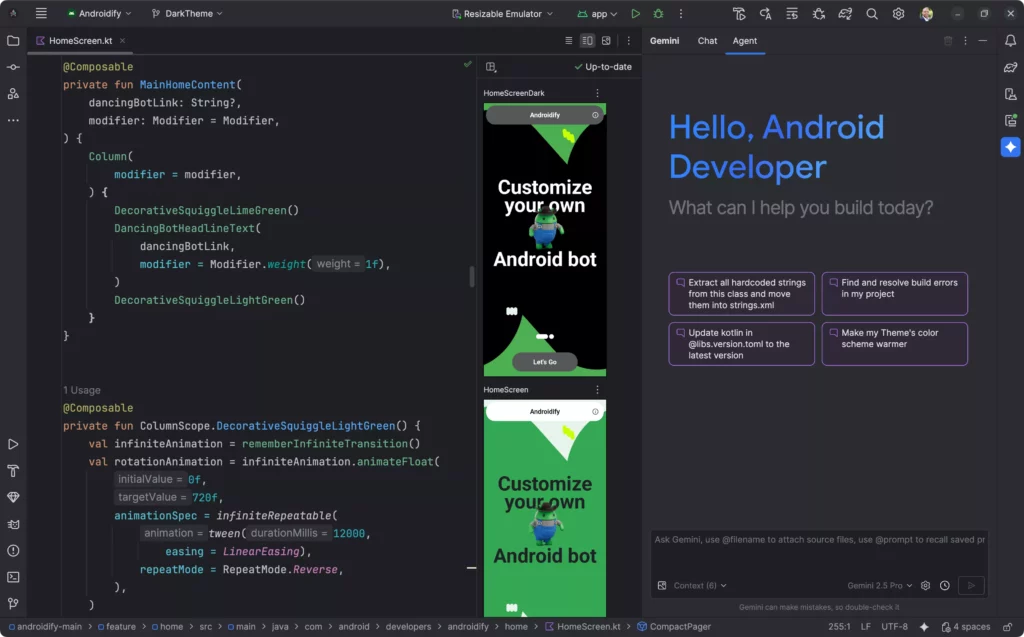
Gemini in Android Studio is an AI coding companion for every stage of Android development.
The AI assistant answers your coding questions, writes new code, finds relevant resources, and suggests best practices. Besides, it can convert selected code in the editor, recommend proper code improvements, and generate commit messages.
With Gemini integrated in Android Studio, you can mock up and troubleshoot Compose UIs, fix Gradle build errors, analyze crashes via integrated Logcat and App Quality Insights, and more.
Pros
- Gemini in Android Studio helps handle Android-specific tasks and works excellently for Kotlin applications.
- The AI assistant doesn’t use your code for model training by default, but lets you fully control your code/IP. It also offers admin controls and compliance features to ensure data privacy and security.
- Gemini can process multimodal inputs. Accordingly, it can transform visuals (e.g., wireframes or mockups) into Jetpack Compose code, interpret diagrams, and help fix UI bugs from screenshots.
- Google constantly releases new features to improve Gemini in Android Studio, from AGENTS.md support (offering project-specific context for more relevant responses) to optimization features (e.g., proguard inspections) and resizable compose preview.
- Gemini in Android Studio now offers MCP support, letting you connect the AI with external tools.
Cons
- Gemini in Android Studio is only available in the latest stable channel version of Android Studio and major versions published 10 months ago. You need to update to these versions if you want to use Gemini.
- The coding assistant is mostly powered by Gemini models.
Pricing
- Free for individual users and students
- Business tiers are available through membership in the Google Developer Program (with at least $299/year) or a subscription to Gemini Code Assist.
10. OpenAI Codex
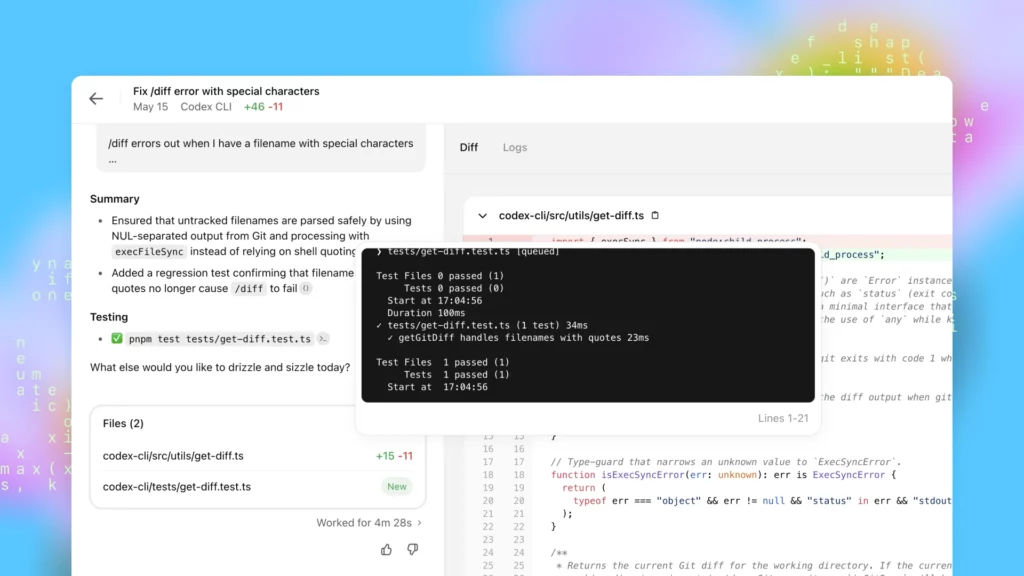
OpenAI Codex is an AI-assisted coding tool trusted by various engineering teams like Cisco or Duolingo.
It excels at handling different coding tasks, like answering questions about codebases, creating new features, fixing bugs, brainstorming solutions, etc. Besides, you can set up Codex to automatically review new PRs and tag @codex to request manual reviews.
You can use Codex via different interfaces (the Codex CLI, IDE extension, or Codex Web) or embed Codex in GitHub Actions and your internal tools (e.g., JavaScript or TypeScript apps). This integration helps you automate key engineering processes, such as CI/CD pipelines, code maintenance, and issue management.
Codex also enables ChatGPT admins to track coding tasks more efficiently through its new admin features (e.g., environment controls and analytics dashboards).
Accordingly, you can delete Codex cloud environments or remove sensitive data in your ChatGPT workspace. You can also track usage across interfaces (e.g., CLI) and the quality of code reviews.
Pros
- Codex can run your code anywhere, whether in your terminal, IDEs, the cloud, GitHub, or on your phone. With your ChatGPT account, you can easily move work between your local environment and Codex’s cloud sandbox.
- Without the need to switch tools, Codex can answer questions, debug, or explore ideas directly in your team’s Slack channels. By automatically getting context from your Slack conversations, Codex can choose the right repo and work on it for better suggestions.
- Codex supports various programming languages (e.g., Python, JavaScript, C++, etc.).
- The tool excels at automating repetitive tasks, ideal for learning, fast prototyping, and feedback loops.
- Codex offers user control features (e.g., diffs/logs of which code changes it suggests) to make coding transparent and avoid unintended behavior.
Cons
- Codex struggles to handle complex, multi-step tasks or vague prompts.
- Codex’s training data has a knowledge cutoff, so the tool may not update the latest libraries, very domain-specific conventions, or recent API changes.
- The tool excels at handling common languages and well-documented APIs. But it struggles with niche languages, very large projects, or complex architecture.
Pricing
OpenAI Codex is included as part of ChatGPT subscription plans, including Plus, Pro, Business, Edu, and Enterprise. No free tiers and no separate base cost for Codex. Paid tiers start at $20/user/month (if billed monthly) with different usage limits.
11. AskCodi

AskCodi is a powerful AI coding assistant that generates consistent, high-quality code within minutes.
As a developer-focused tool, AskCodi offers comprehensive tools, SDKs, and documentation to speed up your coding work. It responds to your coding-related queries using natural language, analyzes your code, and offers proper solutions.
Pros
- AskCodi supports seamless integrations with various IDEs and code editors, like VS Code, IntelliJ, or Neovim.
- The tool lets you access a wide range of AI models, like GPTs, Claude, Gemini, and open-source models (e.g., Llama, Mistral, or CodeLlama).
- You can customize prompts and rules in AskCodi to define AI behavior.
- AskCodi can run your code anywhere, from AskCodi extensions in IDEs/editors and your terminal to internal apps.
- AskCodi secures all your AI interactions with enterprise-grade encryption and secure key management.
- The tool can automatically scale to meet your growing request volume.
Cons
- AskCodi can sometimes create syntactically incorrect code, especially for complex or very domain-specific tasks.
- Some users report lag, especially for complex or very large codebases.
- AskCodi supports various programming languages, but some users say that it lacks full support for newer versions or certain frameworks.
Pricing
- Free with 1M tokens per month
- Paid tiers start at $5/months with 4M tokens and access to all AI models.
12. watsonx Code Assistant
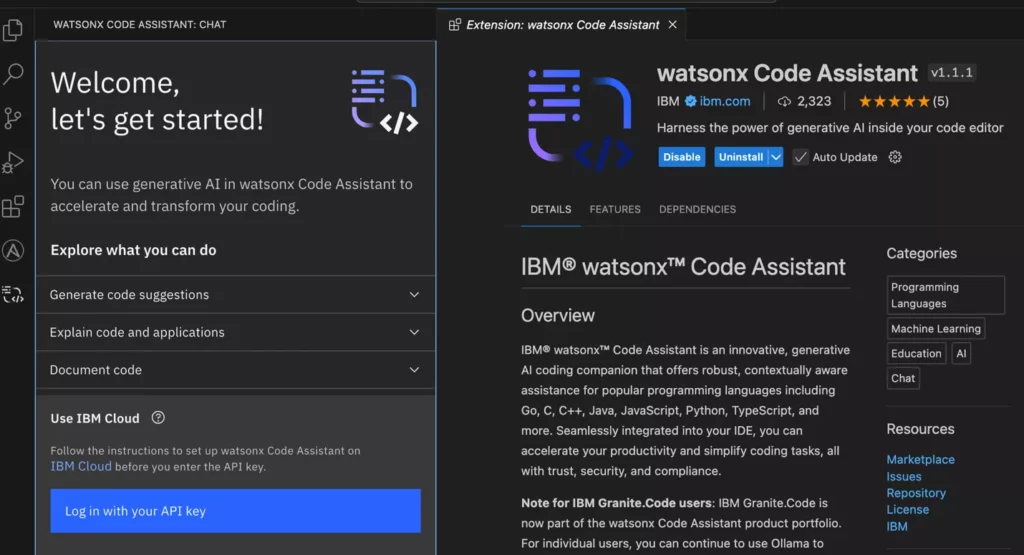
IBM’s watsonx Code Assistant is a trusted partner in your entire development process.
The AI can autocomplete code, explain code, generate test cases, and provide reliable, context-aware suggestions. Beyond these tasks, you can have the AI handling business-critical and complex tasks, like modernizing legacy Java apps and automating repetitive maintenance work.
The AI offers strong security and compliance features, like code similarity checks or traceability of generated code. These features make IBM watsonx Code Assistant useful for companies needing strict compliance with security and regulatory requirements.
Pros
- watsonx Code Assistant promises not to use your code for data training. Further, if you use IBM Granite (their proprietary AI model), the provider offers legal protection (IP indemnity) against code-related claims.
- You can deploy the tool on-premises or on the hybrid cloud to meet data residency and compliance needs.
- The AI integrates well with your existing IDEs and DevOps toolchains to boost developer experiences.
- watsonx Code Assistant supports more than 116 programming languages.
- The tool saves time on various coding tasks. One internal IBM test concluded that IBM watsonx Code Assistant helps their in-house team reduce 59% time on code documentation and 38% on code generation and testing.
Cons
- Some users say that the AI’s setup and integration are sometimes more complex than other tools.
- IBM watsonx Code Assistant may produce less accurate suggestions for complex logic or very domain-specific code.
- No free plan available
Pricing
Paid tiers start at $2 per 20 task prompts with a 30-day trial.
13. Code Llama
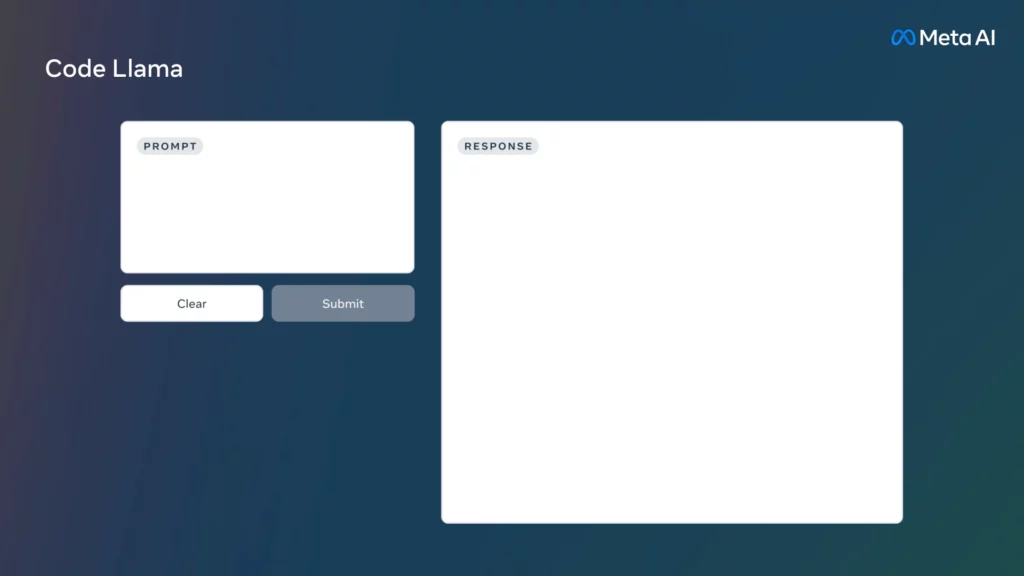
Code Llama is a large language model specifically designed by Meta AI for coding. Trained on code-specific datasets, Code Lama can generate new features, complete code, and support debugging tasks.
Powered by Llama 2, the model comes with various versions: Code Llama (foundation model), Code Llama Python (Python-focused model), and Code Llama Instruct (instruction-following model).
Each has different sizes (7B, 13B, 34B, and 70B parameters) to handle different serving and latency requirements. For example, smaller 7B and 13B models work better for tasks needing low latency, like real-time code completion.
Pros
- Code Llama is released as an open-source model, removing worry about licensing costs.
- The AI coding model performs excellently on coding tasks compared with other tools, with higher scores on HumanEval and MBPP benchmarks.
- It comes with multiple model sizes, each of which has different resource availability and latency requirements.
- Code Llama supports large inputs very well (up to nearly 100K tokens in one Meta research), making it useful for coding tasks that require a deep understanding of a long context.
Cons
- Code Llama is specifically designed for coding, so it’s not good for general NLP tasks (e.g., creative writing).
- The tool struggles to handle very large or highly domain-specific codebases.
Pricing
Code Llama is an open-source model, so it requires no fees.
14. ChatGPT

ChatGPT is the most popular large language model for natural language tasks and even coding assistance.
Although its primary use is not for coding, the model is still the top choice among software developers due to its versatility. It can generate code across multiple programming languages, whether Python, JavaScript, Rust, or C#.
Besides, it can support debugging and error fixing, optimize your code’s performance, write documentation, translate your code to other languages, and generate unit tests. It also explains difficult concepts and guides how to use APIs, SDKs, or third-party libraries.
Pros
- ChatGPT supports multilingual coding and explains language syntax or framework usage excellently.
- The AI model not only generates code but also supports explaining it. This turns it into a versatile mentor for beginners who want to learn new technologies through conversational and practical examples.
- ChatGPT’s paid tiers have a built-in code interpreter and file uploader to analyze codebases, execute code, and review logs directly in the chat.
Cons
- Unlike coding-specific tools (e.g., GitHub Copilot), ChatGPT doesn’t directly access your IDE or local files to offer context-aware responses unless you attach them manually.
- ChatGPT has a knowledge cutoff, so it can create incorrect code, outdated syntax, and non-existent libraries.
Pricing
- Free version available
- Paid tiers start at $20/month (if billed monthly) with different usage limits.
15. Claude Code

The last AI-assisted coding tool in our list is Claude Code. As a powerful pair programmer, it creates new features, analyzes existing code, fixes bugs, and optimizes algorithms with clear explanations.
Powered with Opus 4.1, Sonnet 4.5, and Haiku 3.5, the AI model uses agentic search to understand the context of your entire codebase and make coordinated changes across various files. You can configure Claude to make it adaptable to your coding standards and patterns.
Pros
- Claude Code is natively built in VS Code, but you can run it in any IDE terminal.
- It connects seamlessly with a wide range of command-line tools, like GitHub, Stripe, AWS, or Heroku.
- Experienced developers report higher productivity and reduced workload when working with Claude Code.
- Claude Code excels at making multi-file changes, refactoring code, explaining large codebases, or performing large-scale coding tasks.
Cons
- Tokens burn fast, especially when you work with larger or more complex codebases.
- Claude Code can sometimes make inconsistent or unreliable code suggestions.
- The AI is not suitable for junior developers unless their work is thoroughly supervised and reviewed.
Pricing
- Free version available with limited daily usage
- Paid tiers start at $17/month (billed monthly) for individuals and $150/month for teams
Below is a table comparing all the AI coding tools we discussed in this blog post:
| Tool | Free tiers/trials? | Minimum pricing | Best for |
| GitHub Copilot | ✅ | $10/month | GitHub-integrated development |
| Cursor | ✅ | $20/month | Advanced AI coding |
| Replit | ✅ | $25/month | Browser-based development |
| Bolt | ✅ | $25/month | Quick frontend prototyping & browser-based development |
| Amazon Q Developer | ✅ | $19/month | AWS-related development |
| Tabnine | ✅ | $9/month | Teams requiring on-prem or privacy-first AI coding |
| JetBrains AI Assistant | ✅ | $100/user/year for individuals & $200/user/year for organizations | JetBrains IDE-based development & Kotlin programming |
| Qodo (formerly Codium) | ✅ | $30/month | Test-driven development and code quality |
| Gemini in Android Studio | ✅ | $299/year | Android development |
| OpenAI Codex | ❌ | $20/month | Single-file code completions, fast prototyping, and learning |
| AskCodi | ✅ | $5/month | Quick code generation and documentation |
| watsonx Code Assistant | ✅ | $2/month | Enterprise-driven development & Java modernization, and automation |
| Code Llama | ✅ | ❌ | Teams requiring different model sizes for varied serving and latency requirements |
| ChatGPT | ✅ | $20/month | Teams requiring an all-rounded AI companion for learning, coding, and debugging |
| Claude Code | ✅ | $17/month for individuals & $150/month for teams | Experienced developers working on large-scale projects |
Conclusion
AI-assisted coding tools play an increasingly crucial role in software development. They’re not a complete replacement for software developers, but a collaborative partner to streamline their coding work and boost productivity.
This list has given you the best AI-assisted coding tools to consider in 2025. Have you experienced any of these coding tools or others outside our list? Share your experience with us on Facebook, X, and LinkedIn!


